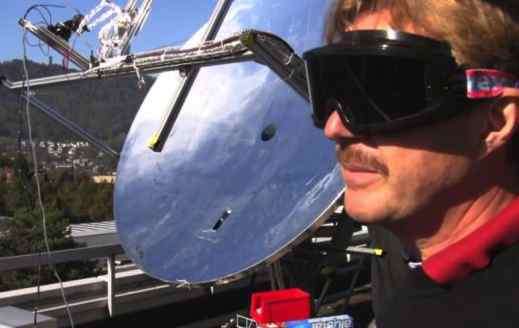
Its manufacturers claim that the Sunflower could soon become the first “drop-in” machine to provide renewable energy, water and heat to off-grid communities in remote regions.
The sun-tracking dish has been designed to be transported in a single shipping container, so it can be delivered to any location. It is being developed by Airlight Energy of Biasca, Switzerland. As well as clean water and electricity, it can generate heat or, with the addition of a heat pump, provide refrigeration.
The core technology is a water-cooled solar panel developed by Bruno Michel and his colleagues at IBM, for which Airlight has licensed the patents. Mirrors on the flower-shaped structure direct the sun’s rays onto six of the panels, where the sunlight is concentrated 2000 times. Photovoltaic cells are cooled by water flowing in microchannels underneath. These carry the heat away at a rate that leaves the microchips at their optimal operating temperature. That makes the Sunflower far more efficient than existing panels, so it needs a quarter of the panels to produce the same power. This makes it cheaper, says Michel.
In coastal areas, the heated water can drive a low-temperature desalinator, also by IBM. It heats seawater to create vapour that passes through a polymer membrane and condenses in a separate chamber. The process is then repeated three times to extract maximum water. IBM claims this can produce 2500 litres of fresh water per day. In non-coastal areas, a water purifier could be fitted instead.
The structure is designed to keep costs down. Solar mirrors would normally be made of heavy, expensive polished glass, but here each 1-metre mirror is made of metallised foil. “The same material potato chip and chocolate wrapping is made of,” says Ilaria Besozzi of Airlight.
If the flow of cooling water failed for any reason, the solar chips would quickly reach 1500 °C and melt. However, a low vacuum keeps the foil mirrors in their concave shape, and releasing this defocuses the sunlight, preventing a solar-chip meltdown.
Tests of an 18-mirror prototype have shown that on solar energy conversion, the Sunflower is 30 per efficient, and on heat, 50 per cent, Airlight says. The final 36-mirror Sunflower (illustrated above) should be able to provide 12 kilowatts of electricity and 20 kilowatts of heat from 10 hours of sun. The firm is also looking at how to store the energy created, including using rocks to store it as heat so that it can be tapped when needed.
Airlight is planning to field test the dish in seven remote sites, likely to be in Morocco and India, in early 2016, before the product proper goes on the market in 2017.
Sunflower will need support, warns Erik Harvey, who coordinates global programmes such as borehole well provision at the London-based charity Water Aid. “Inventions like these create dependencies on supplies of spare parts, skills and consumables. Without a supply chain to provide those things the technology might not be sustainable once it is in place.” Airlight says the Sunflower’s design means it should need minimal maintenance.